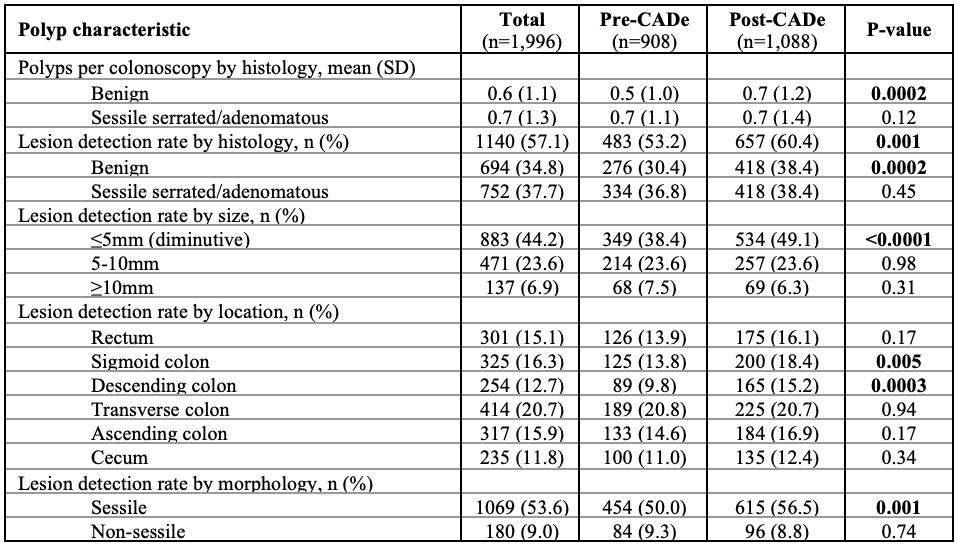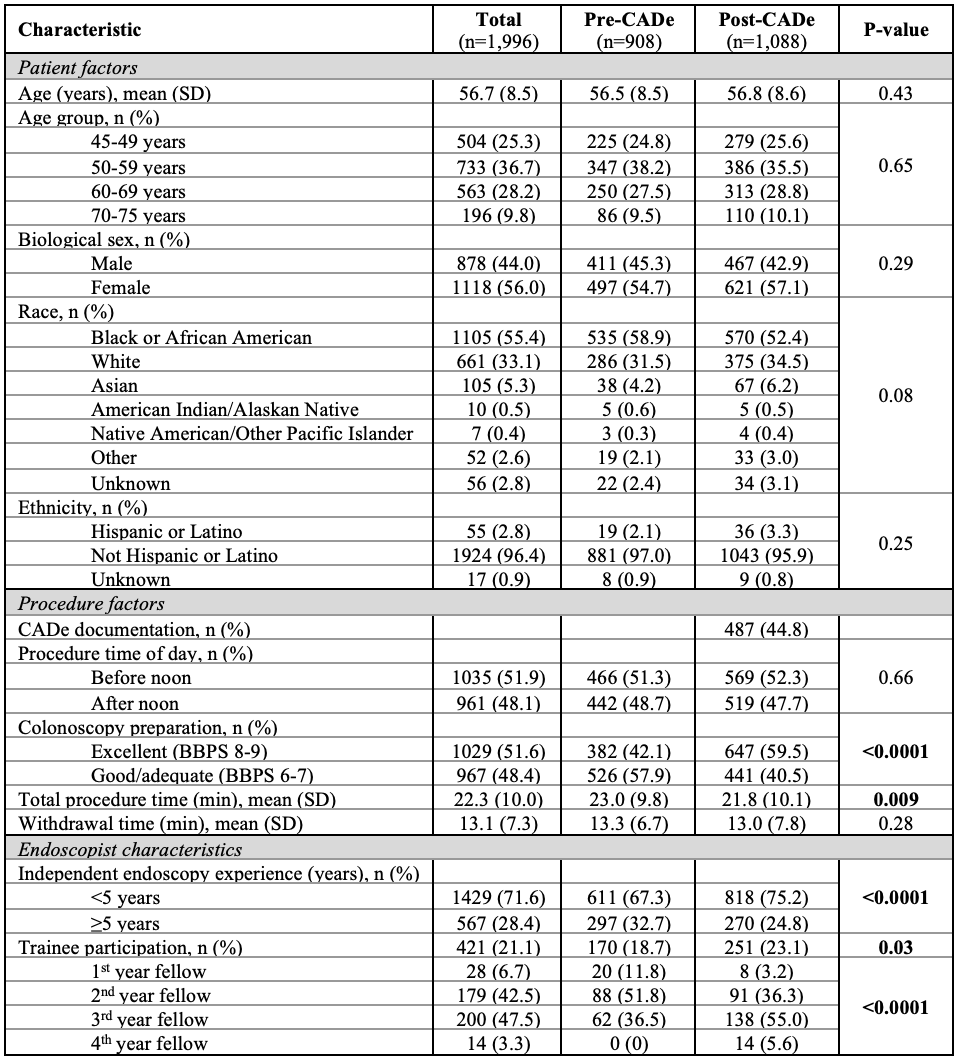Sunday Poster Session
Category: General Endoscopy
P0849 - Real World Analysis of Computer-Aided Detection Associated With Increased Detection of Diminutive Benign Polyps
Sunday, October 26, 2025
3:30 PM - 7:00 PM PDT
Location: Exhibit Hall

Anjeli Manam, MD (she/her/hers)
University of Pennsylvania
Philadelphia, PA
Presenting Author(s)
Hansol Kang, MD1, Anjeli Manam, MD2, Samantha Elias, MD2, Hiba Hameed Chagla, MBBCh3, Tushar Khanna, MD2, Neilanjan Nandi, MD, FACG2
1University of Pennsylvania Health System, Philadelphia, PA; 2University of Pennsylvania, Philadelphia, PA; 3Penn Medicine, Philadelphia, PA
Introduction: Computer-aided detection (CADe) device has shown promise in augmenting adenoma detection rates (ADR). As academic centers incorporate CADe systems into colonoscopy practices, the question arises of how artificial intelligence impacts real world outcomes with regards to ADR as well as detection of polyps subcategorized by size, location, morphology, and histology.
Methods: We conducted a retrospective analysis of screening colonoscopy outcomes at an academic medical center 1 year before (pre-CADe group, October 2021-September 2022) and after (post-CADe group, February 2023-January 2024) the introduction of CADe: Medtronic GI Genius. The study included 21 faculty and 25 fellows. Outcomes included ADR, polyp per colonoscopy categorized by histology, and polyp detection rate categorized by size, location, morphology, and histology. Outcomes were analyzed for differences in pre- and post-CADe groups using Chi-squared analysis for frequencies and T-test analysis for means.
Results: The pre-CADe group included 908 colonoscopies and the post-CADe group included 1,088 colonoscopies. No differences in patient characteristics were observed between the two groups. However, the post-CADe group had a higher proportion of excellent bowel preparations (59.5% vs. 42.1%; p < 0.0001) and shorter mean procedure times (21.8 minutes, SD 10.1 minutes vs. 23.0 minutes, SD 9.8 minutes; p = 0.009) with no significant difference in withdrawal times. The post-CADe group had a higher proportion of endoscopists with < 5 years of independent experience (75.2% vs. 67.3%; p < 0.0001) and fellow participation (23.1% vs. 18.7%; p < 0.0001).
Regarding colonoscopy outcomes, the post-CADe group had higher mean benign polyps per colonoscopy (0.7, SD 1.2 vs. 0.5, SD 1.0; p = 0.0002). The post-CADe group also had higher polyp detection rates for diminutive polyps (49.1% vs. 38.4%; p < 0.0001) located in the sigmoid (18.4% vs. 13.8%; p = 0.005) and descending colon (15.2% vs. 9.8%; p = 0.0003) with sessile morphology (56.5% vs. 50.0%; p = 0.001) and benign histology (38.4% vs. 30.4%; p = 0.0002). There was no significant difference in ADR or sessile serrated lesion detection rate between groups.
Discussion: Introduction of CADe was associated with increased detection of diminutive benign polyps located in the sigmoid and descending colon with no significant impact on ADRs. Results may be confounded by differences in procedure and endoscopist characteristics and further analysis is needed to control for differences between groups.

Figure: Table 1. Characteristics of patients and colonoscopy measures of screening colonoscopies performed pre and post-CADe.

Figure: Table 2. Characteristics of polyps found on screening colonoscopies pre and post-CADe.
Disclosures:
Hansol Kang indicated no relevant financial relationships.
Anjeli Manam indicated no relevant financial relationships.
Samantha Elias indicated no relevant financial relationships.
Hiba Hameed Chagla indicated no relevant financial relationships.
Tushar Khanna indicated no relevant financial relationships.
Neilanjan Nandi: Abbvie, Inc – Advisory Committee/Board Member. Eli Lilly Inc – Advisory Committee/Board Member. Johnson & Johnson – Advisory Committee/Board Member. Sanofi – Advisory Committee/Board Member.
Hansol Kang, MD1, Anjeli Manam, MD2, Samantha Elias, MD2, Hiba Hameed Chagla, MBBCh3, Tushar Khanna, MD2, Neilanjan Nandi, MD, FACG2. P0849 - Real World Analysis of Computer-Aided Detection Associated With Increased Detection of Diminutive Benign Polyps, ACG 2025 Annual Scientific Meeting Abstracts. Phoenix, AZ: American College of Gastroenterology.
1University of Pennsylvania Health System, Philadelphia, PA; 2University of Pennsylvania, Philadelphia, PA; 3Penn Medicine, Philadelphia, PA
Introduction: Computer-aided detection (CADe) device has shown promise in augmenting adenoma detection rates (ADR). As academic centers incorporate CADe systems into colonoscopy practices, the question arises of how artificial intelligence impacts real world outcomes with regards to ADR as well as detection of polyps subcategorized by size, location, morphology, and histology.
Methods: We conducted a retrospective analysis of screening colonoscopy outcomes at an academic medical center 1 year before (pre-CADe group, October 2021-September 2022) and after (post-CADe group, February 2023-January 2024) the introduction of CADe: Medtronic GI Genius. The study included 21 faculty and 25 fellows. Outcomes included ADR, polyp per colonoscopy categorized by histology, and polyp detection rate categorized by size, location, morphology, and histology. Outcomes were analyzed for differences in pre- and post-CADe groups using Chi-squared analysis for frequencies and T-test analysis for means.
Results: The pre-CADe group included 908 colonoscopies and the post-CADe group included 1,088 colonoscopies. No differences in patient characteristics were observed between the two groups. However, the post-CADe group had a higher proportion of excellent bowel preparations (59.5% vs. 42.1%; p < 0.0001) and shorter mean procedure times (21.8 minutes, SD 10.1 minutes vs. 23.0 minutes, SD 9.8 minutes; p = 0.009) with no significant difference in withdrawal times. The post-CADe group had a higher proportion of endoscopists with < 5 years of independent experience (75.2% vs. 67.3%; p < 0.0001) and fellow participation (23.1% vs. 18.7%; p < 0.0001).
Regarding colonoscopy outcomes, the post-CADe group had higher mean benign polyps per colonoscopy (0.7, SD 1.2 vs. 0.5, SD 1.0; p = 0.0002). The post-CADe group also had higher polyp detection rates for diminutive polyps (49.1% vs. 38.4%; p < 0.0001) located in the sigmoid (18.4% vs. 13.8%; p = 0.005) and descending colon (15.2% vs. 9.8%; p = 0.0003) with sessile morphology (56.5% vs. 50.0%; p = 0.001) and benign histology (38.4% vs. 30.4%; p = 0.0002). There was no significant difference in ADR or sessile serrated lesion detection rate between groups.
Discussion: Introduction of CADe was associated with increased detection of diminutive benign polyps located in the sigmoid and descending colon with no significant impact on ADRs. Results may be confounded by differences in procedure and endoscopist characteristics and further analysis is needed to control for differences between groups.

Figure: Table 1. Characteristics of patients and colonoscopy measures of screening colonoscopies performed pre and post-CADe.

Figure: Table 2. Characteristics of polyps found on screening colonoscopies pre and post-CADe.
Disclosures:
Hansol Kang indicated no relevant financial relationships.
Anjeli Manam indicated no relevant financial relationships.
Samantha Elias indicated no relevant financial relationships.
Hiba Hameed Chagla indicated no relevant financial relationships.
Tushar Khanna indicated no relevant financial relationships.
Neilanjan Nandi: Abbvie, Inc – Advisory Committee/Board Member. Eli Lilly Inc – Advisory Committee/Board Member. Johnson & Johnson – Advisory Committee/Board Member. Sanofi – Advisory Committee/Board Member.
Hansol Kang, MD1, Anjeli Manam, MD2, Samantha Elias, MD2, Hiba Hameed Chagla, MBBCh3, Tushar Khanna, MD2, Neilanjan Nandi, MD, FACG2. P0849 - Real World Analysis of Computer-Aided Detection Associated With Increased Detection of Diminutive Benign Polyps, ACG 2025 Annual Scientific Meeting Abstracts. Phoenix, AZ: American College of Gastroenterology.

